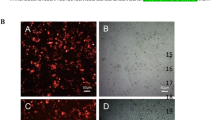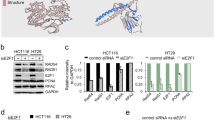Abstract
Hec1 (highly expressed in cancer) plays an important role in chromosome segregation by interacting with a subset of checkpoint proteins that survey proper chromosome alignment and bipolar spindle attachment. In order to disrupt mitotic progression of tumor cell lines, we have used retrovirus and adenovirus vectors that inhibit Hec1 synthesis. Vector-expressed short hairpin RNAs (shRNAs) caused very efficient depletion of the target protein, cellular arrest and considerable mitotic catastrophe induction 96 h post infection in human cervix-adenocarcinoma (HeLa) and glioblastoma (U-373-MG) cell lines. Furthermore, adenocarcinomas induced in the flanks of nude mice show significant reduction in size compared with control when treated with either Hec1-shRNA retroviruses or adenoviruses. These results indicate that depletion of Hec1 could be used as a new strategy to block the dividing cell, and therefore against cancer.
This is a preview of subscription content, access via your institution
Access options
Subscribe to this journal
Receive 12 print issues and online access
$259.00 per year
only $21.58 per issue
Buy this article
- Purchase on Springer Link
- Instant access to full article PDF
Prices may be subject to local taxes which are calculated during checkout




Similar content being viewed by others
Accession codes
Abbreviations
- RNAi:
-
RNA interference
- dsRNA:
-
double-stranded RNA
- shRNAs:
-
short hairpin RNAs
- RISC:
-
RNA-induced silencing complex
- Hec1:
-
highly expressed in cancer
- pRiHec1:
-
retroviral plasmid carrying the DNA corresponding to Hec1-shRNA.
References
Fire A, Xu S, Montgomery MK, Kostas SA, Driver SE, Mello CC . Potent and specific genetic interference by double-stranded RNAi in Caenorhabditis elegans. Nature 1998; 391: 806–811.
Cerutti H . RNA interference: traveling in the cell and gaining functions? TRENDS Genet 2003; 19: 39–46.
Hannon GJ, Rossi JJ . Unlocking the potential of the human genome with RNA interference. Nature 2004; 431: 371–378.
Izquierdo M . Short interfering RNAs as a tool for cancer gene therapy. Cancer Gene Ther 2005; 12: 217–227.
Elbashir SM, Harborth J, Lendeckel W, Yalcin A, Weber K, Tuschl T . Duplexes of 21-nucleotide RNAs mediate RNA interference in cultured mammalian cells. Nature 2001; 411: 494–498.
Hannon GJ . RNA interference. Nature 2002; 418: 244–251.
McManus MT, Sharp PA . Gene silencing in mammals by small interfering RNAs. Nat Rev Genet 2002; 3: 737–747.
Brummelkamp TR, Bernards R, Agami RA . System for stable expression of short interfering RNAs in mammalian cells. Science 2002; 296: 550–553.
Brummelkamp TR, Bernards R, Agami R . Stable suppression of tumorigenicity by virus-mediated RNA interference. Cancer Cell 2002; 2: 243–247.
Devroe E, Silver PA . Retrovirus-delivered shRNA. BMC Biotechnol 2002; 2: 15–20.
Cleveland DW, Mao Y, Sullivan KF . Centromeres and kinetochores: from epigenetics to mitotic checkpoint signaling. Cell 2003; 112: 407–421.
Obuse C, Iwasaki O, Kiyomitsu T, Goshima G, Toyoda Y, Yanagida M . A conserved Mis12 centromere complex is linked to heterochromatic HP1 and outer kinetochore protein Zwint-1. Nat Cell Biol 2004; 6: 1135–1141.
Steensgaard P, Garre M, Muradore I, Transidico P, Nigg EA, Kitagawa K et al. Sgt1 is required for human kinetochore assembly. EMBO Rep 2004; 5: 626–631.
Wigge PA, Kilmartin JJ . The Ndc80p complex from Saccharomyces cerevisiae contains conserved centromere components and has a function in chromosome segregation. J Cell Biol 2001; 152: 349–360.
Martin-Lluesma S, Stucke VM, Nigg EA . Role of Hec1 in spindle checkpoint signaling and kinetochore recruitment of Mad1/Mad2. Science 2002; 297: 2267–2270.
DeLuca JG, Moree B, Hickey JM, Kilmartin JV, Salmon ED . hNuf2 inhibition blocks stable kinetochore-microtubule attachment and induces mitotic cell death in HeLa cells. J Cell Biol 2002; 159: 549–554.
DeLuca JG, Howell BJ, Canman JC, Hickey JM, Fang G, Salmon ED . Nuf2 and Hec1 are required for retention of the checkpoint proteins Mad1 and Mad2 to kinetochores. Curr Biol 2003; 13: 2103–2109.
Chen Y, Riley DJ, Zheng L, Chen PL, Lee WH . Phosphorilation of the mitotic regulator protein Hec1 by Nek2 kinase is essential for faithful chromosome segregation. J Biol Chem 2002; 277: 49408–49416.
Miller DG, Adam MA, Miller AD . Gene transfer by retrovirus vectors occurs only in cells that are actively replicating at the time of infection. Mol Cell Biol 1990; 10: 4239–4242.
Cahill DP, Lengauer C, Yu J, Riggins GJ, Willson JK, Markowitz SD et al. Mutations of mitotic checkpoint genes in human cancers. Nature 1998; 392: 300–303.
Lengauer C, Kinzler KW, Vogelstein B . Genetic instabilities in human cancers. Nature 1998; 396: 643–649.
de la Hoz C, Baroja A . Proliferative behaviour of high-ploidy cells in two murine tumour lines. J Cell Sci 1993; 104: 31–36.
Li K, Lin S, Brunicardi FC, Seu P . Use of RNA interference to target cyclin E-overexpressing hepatocellular carcinoma. Cancer Res 2003; 63: 3593–3597.
Wilda M, Fuchs U, Wossmann W, Borkhardt A . Killing of leukemic cells with a BCR/ABL fusion gene by RNA interference (RNAi). Oncogene 2002; 21: 5716–5724.
Scherr M, Battmer K, Winkler T, Heidenreich O, Ganser A, Eder M . Specific inhibition of bcr-abl gene expression by small interfering RNA. Blood 2003; 101: 1566–1569.
Nieth C, Priebsch A, Stege A, Lage H . Modulation of the classical multidrug resistance (MDR) phenotype by RNA interference (RNAi). FEBS Lett 2003; 545: 144–150.
Duxbury MS, Ito H, Benoit E, Zinner MJ, Ashley SW, Whang EE . RNA interference targeting the M2 subunit of ribonucleotide reductase enhances pancreatic adenocarcinoma chemosensitivity to gemcitabine. Oncogene 2004; 23: 1539–1548.
Filleur S, Courtin A, Ait-Si-Ali S, Guglielmi J, Merle C, Harel-Bellan A et al. siRNA-mediated inhibition of vascular endothelial growth factor severely limits tumor resistance to antiangiogenic thrombospondin-1 and slows tumor vascularization and growth. Cancer Res 2003; 63: 3919–3922.
Muruve DA . The innate immune response to adenovirus vectors. Human Gene Ther 2004; 15: 1157–1166.
Zhou H, Xia XG, Xu Z . An RNA polymerase II construct synthesizes short-hairpin RNA with a quantitative indicator and mediates highly efficient RNAi. Nucleic Acids Res 2005; 33: doi: 10.1093/nar/gni061.
Lakka SS, Gondi CS, Yanamandra N, Olivero WC, Dinh DH, Gujrati M et al. Inhibition of cathepsin B and MMP-9 gene expression in glioblastoma cell line via RNA interference reduces tumor cell invasion, tumor growth and angiogenesis. Oncogene 2004; 23: 4681–4689.
Izquierdo M, Cortes ML, Martin V, de Felipe P, Izquierdo JM, Perez-Higueras A et al. Gene therapy in brain tumours: implications of the size of glioblastoma on its curability. Acta Neurochir Suppl 1997; 68: 111–117.
Acknowledgements
We are indebted to Dr John Kilmartin (MRC Laboratory of Molecular Biology, Cambridge, UK) for providing anti-Hec1 antibody several times. This study was supported by a grant from the Comunidad de Madrid 08.1/0039.1/2003 and from the Ministerio de Ciencia y Tecnología SAF 2002-01100. The Centro de Biología Molecular S.O. is also the recipient of an institutional grant from the Ramón Areces Foundation. EN Gurzov was supported by a grant from the Fundación Carolina-Ministerio de Asuntos Exteriores de España.
Author information
Authors and Affiliations
Corresponding author
Rights and permissions
About this article
Cite this article
Gurzov, E., Izquierdo, M. RNA interference against Hec1 inhibits tumor growth in vivo. Gene Ther 13, 1–7 (2006). https://doi.org/10.1038/sj.gt.3302595
Received:
Revised:
Accepted:
Published:
Issue Date:
DOI: https://doi.org/10.1038/sj.gt.3302595
Keywords
This article is cited by
-
Novel small molecules disrupting Hec1/Nek2 interaction ablate tumor progression by triggering Nek2 degradation through a death-trap mechanism
Oncogene (2015)
-
N-terminus-modified Hec1 suppresses tumour growth by interfering with kinetochore–microtubule dynamics
Oncogene (2015)
-
Characterization of the biological activity of a potent small molecule Hec1 inhibitor TAI-1
Journal of Experimental & Clinical Cancer Research (2014)
-
An RNAi-based screen reveals PLK1, CDK1 and NDC80 as potential therapeutic targets in malignant pleural mesothelioma
British Journal of Cancer (2014)
-
Mitosis as an anti-cancer drug target
Chromosoma (2013)



